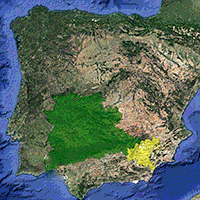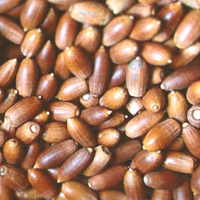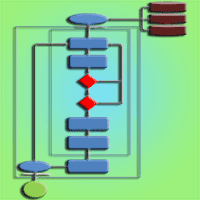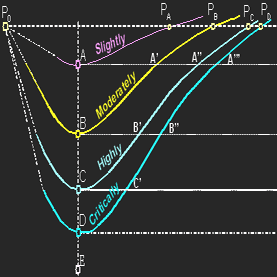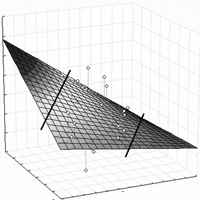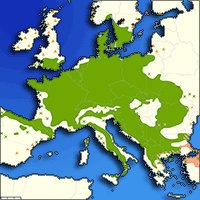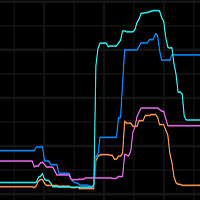Diversification of genetic plant material in forest plantations is viewed as a promising strategy to promote forest adaptation and resilience to ongoing climate change. However, there is an intense debate about whether foreign populations might outperform local ones under new climatic conditions. Unfortunately, long-term experiments using contrasting provenances are scarce, especially in the Mediterranean region. In this context, the evaluation of the resistance and resilience of individuals from different provenances to drought can help to forecast their performance under different climate change scenarios, and therefore to establish guideline regarding plant material selection in reforestation projects. We evaluated the performance (survival and drought) and drought sensitivity of Quercus ilex saplings from two contrasting provenances growing during eight years in a common garden experiment. For this, we used a combination of dendroecological methods and water-relation measurements, such as leaf water potential (Ψpd), cuticular transpiration (Ec), relative water content at the point of stomatal closure (RWCc) and specific leaf area (SLA). We also compared the resilience and resistance, in terms of radial growth to the intense drought event of 2012 between saplings from both provenances. Our results suggest a lack of idiosyncratic physiological response and growth sensitivity to drought between provenances. However, saplings from the drier provenance showed a superior performance in terms of survival and growth. Survival was greater in saplings from the dry provenance (100 vs. 91 %). Mean annual basal area increment was also greater in saplings from the dry provenance (158.8 ± 13.5 vs. 96.2 ± 8.4 mm2), which resulted in greater diameter eight year after planting (47.5 ± 2.8 vs. 38.3 ± 2.3 mm). The lower values of Ψpd, Ec and SLA in the summer of the first two years after planting suggest that climatic conditions after planting rather than isolated drought events was the most critical period for the success of these saplings. In view of our results, the selection of plant material for forest plantation should be carefully evaluated in forest restoration projects, while priority should be given to those actions oriented to increase the early survival of local Q. ilex seedlings.
Keywords
, , , , , ,
Citation
Andivia E, Natalini F, Fernández M, Alejano R, Vázquez-Piqué J (2018). Contrasting holm oak provenances show different field performance but similar resilience to drought events eight years after planting in a Mediterranean environment. iForest 11: 259-266. - doi: 10.3832/ifor2573-011
Academic Editor
Tamir Klein
Paper history
Received: Jul 29, 2017
Accepted: Jan 15, 2018
First online: Mar 29, 2018
Publication Date: Apr 30, 2018
Publication Time: 2.43 months
© SISEF - The Italian Society of Silviculture and Forest Ecology 2018
Open Access
This article is distributed under the terms of the Creative Commons Attribution-Non Commercial 4.0 International (https://creativecommons.org/licenses/by-nc/4.0/), which permits unrestricted use, distribution, and reproduction in any medium, provided you give appropriate credit to the original author(s) and the source, provide a link to the Creative Commons license, and indicate if changes were made.

Breakdown by View Type
(Waiting for server response...)
Article Usage
Total Article Views: 49871
(from publication date up to now)
Breakdown by View Type
HTML Page Views: 41931
Abstract Page Views: 3275
PDF Downloads: 3620
Citation/Reference Downloads: 25
XML Downloads: 1020
Web Metrics
Days since publication: 2801
Overall contacts: 49871
Avg. contacts per week: 124.63
Article Citations
Article citations are based on data periodically collected from the Clarivate Web of Science web site
(last update: Mar 2025)
Total number of cites (since 2018): 7
Average cites per year: 0.88
Publication Metrics
by Dimensions ©
Articles citing this article
List of the papers citing this article based on CrossRef Cited-by.
(1)
Aitken SN, Whitlock MC (2013)Assisted gene flow to facilitate local adaptation to climate change. Annual Review of Ecology, Evolution and Systematics 44: 367-388.
CrossRef |
Gscholar
(2)
Alía R, García del Barrio JM, Iglesias S, Mancha JA, De Miguel J, Nicolás JL, Pérez F, Sánchez de Ron D (2009)Regiones de procedencia de especies forestales en España [Provenances of Spanish forest species]. Organismo Autónomo Parques Nacionales, Madrid, Spain, pp. 363. [in Spanish]
Online |
Gscholar
(3)
Andivia E, Carevic F, Fernández M, Alejano R, Vázquez-Piqué J, Tapias R (2012a)Seasonal evolution of water status after outplanting of two provenances of Holm oak nursery seedlings. New Forests 43: 815-824.
CrossRef |
Gscholar
(4)
Andivia E, Fernández M, Vázque-Piqué J, Alejano R (2012b)Two provenances of
Quercus ilex ssp.
ballota (Desf) Samp. nursery seedlings have different response to frost tolerance and autumn fertilization. European Journal of Forest Research 131: 1091-1101.
CrossRef |
Gscholar
(5)
Andivia E, Fernández M, Vázquez-Piqué J (2014)Assessing the effect of late-season fertilization on Holm oak plant quality: insights from morpho-nutritional characterizations and water relations parameters. New Forests 45: 149-163.
CrossRef |
Gscholar
(6)
Bates D, Maechler M, Bolker B, Walker S (2015)Fitting linear mixed-effects models using lme4. Journal of Statistical Software 67: 1-48.
CrossRef |
Gscholar
(7)
Benito-Garzón M, Sánchez De Dios R, Sainz-Ollero H (2008)Effects of climate change on the distribution of Iberian tree species. Applied Vegetation Sciences 11: 169-178.
CrossRef |
Gscholar
(8)
Benomar L, Lamhamedi MS, Rainville A, Beaulieu J, Bousquet J, Margolis HA (2016)Genetic adaptation
vs. ecophysiological plasticity of photosynthetic-related traits in young
Picea glauca trees along a regional climatic gradient. Frontiers in Plant Sciences 7: 48.
CrossRef |
Gscholar
(9)
Biondi F, Qeadan F (2008)A theory-driven approach to tree-ring standardization: defining the biological trend from expected basal area increment. Tree-Ring Research 64: 81-96.
CrossRef |
Gscholar
(10)
Bucharova A (2017)Assisted migration within species range ignores biotic interactions and lacks evidence. Restoration Ecology 25: 14-18.
CrossRef |
Gscholar
(11)
Bunn AG (2008)A dendrochronology program library in R (dplR). Dendrochronologia 26: 115-124.
CrossRef |
Gscholar
(12)
Burnham KP, Anderson DR (2002)Model selection and multimodel inference: a practical information-theoretic approach. Springer-Verlag, New York, USA, pp. 488.
CrossRef |
Gscholar
(13)
Bussotti F, Pollastroni M, Holland V, Brüggemann W (2015)Functional traits and adaptive capacity of European forests to climate change. Environmental and Experimental Botany 111: 91-113.
CrossRef |
Gscholar
(14)
Cuesta B, Villar-Salvador P, Puértolas J, Jacobs DF, Benayas JMR (2010)Why do large, nitrogen rich seedlings better resist stressful transplanting conditions? A physiological analysis in two functionally contrasting Mediterranean forest species. Forest Ecology and Management 260: 71-78.
CrossRef |
Gscholar
(15)
Gimeno TE, Pías B, Lemos-Filho P, Valladares F (2008)Plasticity and stress tolerance override local adaptation in the responses of Mediterranean holm oak seedlings to drought and cold. Tree Physiology 29: 87-98.
CrossRef |
Gscholar
(16)
Giorgi F (2006)Climate change hot-spots. Geophysical Research Letters 33 (8): 89.
CrossRef |
Gscholar
(17)
Gratani L, Meneghini M, Pesoli P, Crescente MF (2003)Structural and functional plasticity of
Quercus ilex seedlings of different provenances in Italy. Trees, Structure and Function 17: 515-521.
CrossRef |
Gscholar
(18)
Grossnickle SC (2012)Why seedlings survive: influence of plant attributes. New Forests 43: 711-738.
CrossRef |
Gscholar
(19)
Leland C, Hom J, Skowronsky N, Ledig FT, Krusic PJ, Cook ER, Martin-Benito D, Martín-Fernández J, Pederson N (2016)Missing rings, synchronous growth, and ecological disturbance in a 36-year pitch pine (
Pinus rigida) provenance study. PLoS ONE 11 (5): e0154730.
CrossRef |
Gscholar
(20)
Lindner M, Fitzgerald JB, Zimmermann NE, Reyer C, Delzon S, Van Der Maaten E, Schelhaas MJ, Lasch P, Eggers J, Van Der Maaten-Theunissen M, Suckow F, Psomas A, Poulter B, Hanewinkel M (2014)Climate change and European forests: what do we know, what are the uncertainties, and what are the implications for forest management? Journal of Environmental Management 146: 69-83.
CrossRef |
Gscholar
(21)
Löf M, Dey DC, Navarro RM, Jacobs DF (2012)Mechanical site preparation for forest restoration. New Forests 43: 825-848.
CrossRef |
Gscholar
(22)
Lloret F, Keeling EG, Sala A (2011)Components of tree resilience: effects of successive low-growth episodes in old ponderosa pine forests. Oikos 120: 1909-1920.
CrossRef |
Gscholar
(23)
Marqués L, Camarero JJ, Gazol A, Zavala MA (2016)Drought impacts on tree growth of two pine species along an altitudinal gradient and their use as early-warning signals of potential shifts in tree species distributions. Forest Ecology and Management 381: 157-167.
CrossRef |
Gscholar
(24)
Matías L, González-Díaz P, Jump AS (2014)Larger investment in roots in southern range-edge populations of Scots pine is associated with increased growth and seedling resistance to extreme drought in response to simulated climate change. Environmental and Experimental Botany 105: 32-38.
CrossRef |
Gscholar
(25)
McDowell N, Pockman WT, Allen CD, Breshears DD, Cobb N, Kolb T, Plaut J, Sperry J, West A, Williams DG, Yepez EA (2008)Mechanisms of plant survival and mortality during drought: why do some plants survive while others succumb to drought? New Phytologist 178: 719-739.
CrossRef |
Gscholar
(26)
Nakagawa S, Schielzeth H (2013)A general and simple method for obtaining R
2 from generalized linear mixed-effects models. Methods in Ecology and Evolution 4: 132-142.
CrossRef |
Gscholar
(27)
Padilla FM, Pugnaire FI (2007)Rooting depth and soil moisture control Mediterranean woody seedling survival during drought. Functional Ecology 21: 489-495.
CrossRef |
Gscholar
(28)
Pesoli P, Gratani L, Larcher W (2003)Responses of
Quercus ilex from different provenances to experimentally imposed water stress. Biologia Plantarum 46: 577-581.
CrossRef |
Gscholar
(29)
Pluess AR, Frank A, Heiri C, Lalagüe H, Vendramin GG, Oddou-Muratorio S (2016)Genome-environment association study suggests local adaptation to climate at the regional scale in
Fagus sylvatica. New Phytologist 210: 589-601.
CrossRef |
Gscholar
(30)
Quisenberry JE, Roark B, McMichael B (1982)Use of transpiration decline curves to identify drought tolerant cotton germplasm. Crop Sciences 22: 918-922.
CrossRef |
Gscholar
(31)
Ramírez-Valiente JA, Valladares F, Huertas AD, Granados S, Aranda I (2011)Factors affecting cork oak growth under dry conditions: local adaptation and contrasting additive genetic variance within populations. Tree Genetics and Genomes 7: 285-295.
CrossRef |
Gscholar
(32)
Rodá F, Retana J, Gracia CA, Bellot J (1999)Ecology of Mediterranean evergreen oak forests. Springer, Berlin, Germany, pp. 377.
Online |
Gscholar
(33)
Ruiz-Benito P, Lines ER, Gómez-Aparicio L, Zavala MA, Coomes DA (2013)Patterns and drivers of tree mortality in Iberian forests: climatic effects are modified by competition. PLoS ONE 8 (2): e56843.
CrossRef |
Gscholar
(34)
Sánchez-Salguero R, Navarro-Cerrillo RM, Camarero JJ, Fernández-Cancio A (2012)Selective drought-induced decline of pine species in southeastern Spain. Climatic Change 113: 767-785.
CrossRef |
Gscholar
(35)
Savolainen O, Pyhäjärvi T, Knürr T (2007)Gene flow and local adaptation in trees. Annual Review of Ecology, Evolution and Systematics 38: 595-619.
CrossRef |
Gscholar
(36)
Savva Y, Denneler B, Koubaa A, Tremblay F, Bergeron Y, Tjoelker MG (2007)Seed transfer and climate change effects on radial growth of jack pine populations in a common garden in Petawawa, Ontario, Canada. Forest Ecology and Management 242: 636-647.
CrossRef |
Gscholar
(37)
Scholander P, Hammel H, Bradstreet E, Hemmingsen E (1965)Sap pressure in vascular plants. Negative hydrostatic pressure can be measured in plants. Science 148: 339-346.
CrossRef |
Gscholar
(38)
Schwartz MW, Hellmann JJ, Mclachlan JM, Sax DF, Borevitz JO, Brennan J, Camacho AE, Ceballos G, Clark JR, Doremus H, Early R (2012)Managed relocation: integrating the scientific, regulatory, and ethical challenges. BioScience 62: 732-743.
CrossRef |
Gscholar
(39)
Valladares F, Martinez-Ferri E, Balaguer L, Perez-Corona E, Manrique E (2000)Low leaf-level response to light and nutrients in Mediterranean evergreen oaks: a conservative resource-use strategy? New Phytologist 148: 79-91.
CrossRef |
Gscholar
(40)
Valladares F, Gianoli E, Gómez JM (2007)Ecological limits to plant phenotypic plasticity. New Phytologist 176: 749-763.
CrossRef |
Gscholar
(41)
Van Der Maaten-Theunissen M, Van Der Maaten E, Bouriaud O (2015)pointRes: an R package to analyze pointer years and components of resilience. Dendrochronologia 35: 34-38.
CrossRef |
Gscholar
(42)
Vicente-Serrano S, Beguería S, López-Moreno JI (2010)A multiscalar drought index sensitive to global warming: the standardized precipitation evapotranspiration index. Journal of Climate 23: 1696-1718.
CrossRef |
Gscholar
(43)
Villar-Salvador P, Planelles R, Enriquez E, Peñuelas-Rubira JL (2004)Nursery cultivation regimes, plant functional attributes, and field performance relationships in the Mediterranean oak
Quercus ilex L. Forest Ecology and Management 196: 257-266.
CrossRef |
Gscholar
(44)
Villar-Salvador P, Puértolas J, Cuesta B, Penuelas JL, Uscola M, Heredia-Guerrero N, Benayas JMR (2012)Increase in size and nitrogen concentration enhances seedling survival in Mediterranean plantations. Insights from an ecophysiological conceptual model of plant survival. New Forests 43: 755-770.
CrossRef |
Gscholar
(45)
Villar-Salvador P, Nicolás-Peragón JL, Heredia-Guerrero N, Uscola M (2013)Quercus ilex L. In: “Producción y Manejo de Semillas y Plantas Forestales. Tomo II” [Production and management of forest seeds and plants. Volume II] (Pemán J, Navarro-Cerrillo RM, Nicolás JL, Prada MA, Serrada R eds). Organismo Autónomo Parques Nacionales, Madrid, Spain, pp. 226-250. [in Spanish]
Online |
Gscholar
